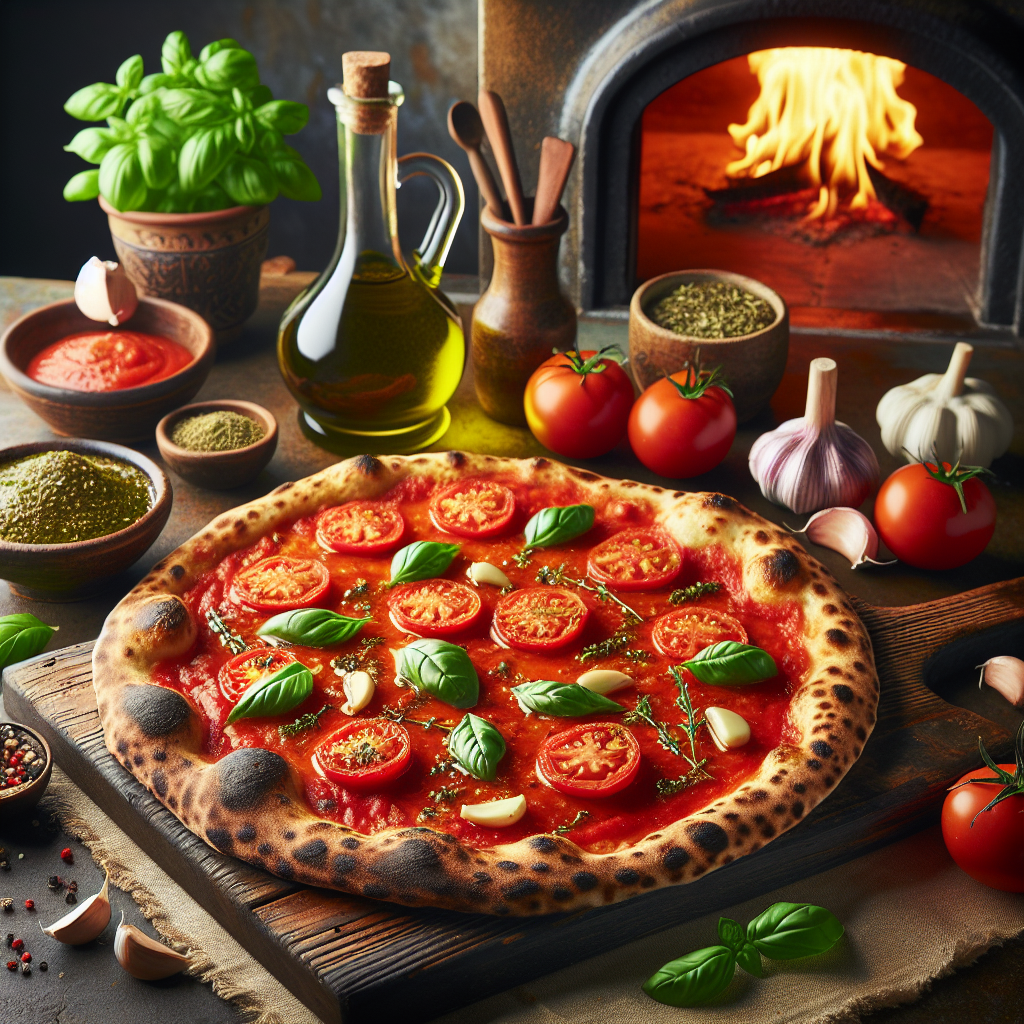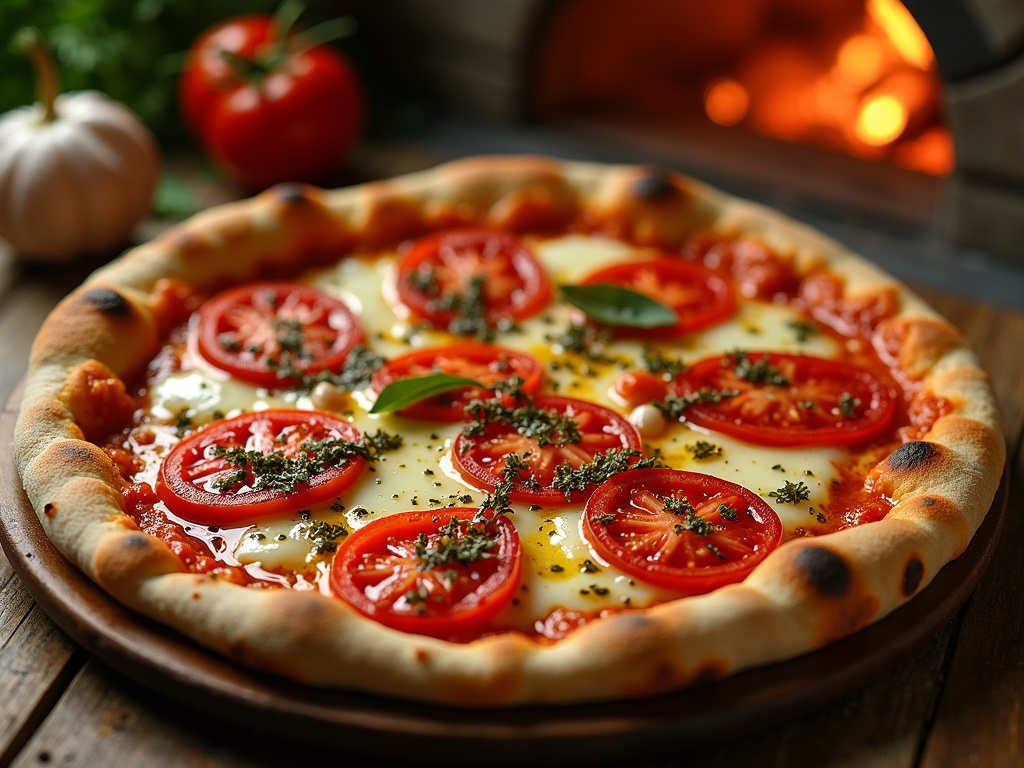Pizza marinara dates back to 18th century Naples, showcasing Italian culinary minimalism with a heritage now protected by UNESCO as an Intangible Cultural Heritage. Italian fishermen named this simple pizza made with just tomatoes, garlic, oregano, and olive oil because it stayed fresh during their long sea journeys.
Find In This Article
Key Takeaways
- The absence of cheese made pizza marinara particularly suitable for long sea voyages, as dairy would quickly spoil in the Mediterranean climate.
- Traditional preparation requires hand-kneaded dough, San Marzano tomatoes grown in volcanic soil, fresh garlic, dried oregano, and high-quality olive oil.
- The Associazione Verace Pizza Napoletana (AVPN) maintains strict standards for authentic marinara, including cooking in wood-fired ovens reaching 900°F.
- The dough requires proper technique with 00 flour and a 65% water hydration ratio, followed by a 24-48 hour fermentation period for complex flavor development.
- Despite its simplicity, pizza marinara has gained global popularity as consumers increasingly value authentic, traditional preparations focused on quality ingredients.
I’ve found that this pizza’s history perfectly captures why simple food often creates the most profound culinary experiences. The marinara’s staying power comes from both practical origins and exceptional flavor built on minimal but perfect ingredients.
The Ancient Origins of Naples’ Simplest Pizza
Pizza marinara holds a special place in my heart as I explore the rich tapestry of Italian culinary history. This humble yet magnificent creation dates back to the 18th century in Naples, Italy, making it one of the oldest known pizzas in existence. Its beautiful simplicity has stood the test of time, embodying the essence of authentic Italian dishes at their finest.
The name ‘marinara’ translates to ‘sailor-style,’ which reveals much about its practical origins. This pizza earned its name due to its immense popularity among Italian fishermen who would take these easily preserved pizzas on their long journeys at sea. I find it fascinating how necessity often breeds the most enduring culinary traditions.
A Heritage Worth Protecting
In 2017, the cultural significance of traditional Neapolitan pizza-making received well-deserved recognition when UNESCO declared it an Intangible Cultural Heritage of Humanity. This prestigious acknowledgment highlights not just the dish itself, but the craft, tradition, and cultural importance behind pizza marinara and other traditional Italian recipes.
What made pizza marinara so perfect for seafarers was its ingenious composition of simple, preservable ingredients that didn’t spoil easily during extended fishing expeditions. The fishermen valued this practical meal that could be prepared quickly and kept well without refrigeration – a genuine challenge in earlier centuries.
The beauty of marinara lies in its minimalist approach – a thin, soft crust topped with just tomatoes, garlic, oregano, and olive oil. No cheese appears on an authentic marinara, setting it apart from many modern interpretations of pizza. This absence of dairy made it particularly suitable for long sea journeys, as cheese would quickly spoil in the warm Mediterranean climate.
I’ve discovered that while pizza marinara lacks the complexity of toppings found in more elaborate Italian recipes, it compensates with depth of flavor. The high-quality olive oil, sweet tomatoes, and aromatic garlic and oregano combine to create a symphony of taste that truly captures the essence of southern Italian cuisine.
The traditional preparation remains largely unchanged since those early days. Neapolitan pizzaiolos still prepare the dough by hand, letting it rise slowly before stretching it thin. They top it with crushed San Marzano tomatoes grown in the volcanic soil near Mount Vesuvius, fresh garlic, dried oregano, and a generous drizzle of olive oil before baking it quickly in intensely hot wood-fired ovens.
This historical pizza has influenced countless variations across Italy and around the world. Its fundamental techniques and flavor profiles have inspired everything from hearty meat sauces to herb-based condiments that define Italian cuisine today.
Despite its humble origins as fisherman’s fare, pizza marinara has transcended class boundaries to become beloved by people from all walks of life. Its cultural impact extends far beyond Italy’s borders, influencing global perceptions of what pizza can be at its most authentic and elemental form.
What I find most remarkable about pizza marinara is how it embodies the core philosophy of traditional Italian cooking – using few, high-quality ingredients to create something greater than the sum of its parts. This principle applies equally to other foundational elements of Italian cuisine, from classic sauces to pasta preparations.
What Makes an Authentic Marinara
Authentic pizza marinara stands as a testament to Italian culinary simplicity. I’ve found that the beauty of this classic lies in its minimalist approach – focusing on quality ingredients rather than quantity. The marinara embodies the essence of traditional Italian cuisine with just a handful of carefully selected components.
The Essential Ingredients
San Marzano tomatoes form the backbone of any authentic marinara. These aren’t just any tomatoes – they must be D.O.P. certified (Denominazione di Origine Protetta), grown in specific volcanic soil regions of Italy. Their unique sweet flavor and low acidity create the perfect base for the sauce.
Fresh garlic is sliced thin, never minced or crushed, to release its aroma gradually during baking. Extra virgin olive oil should be high-quality and cold-pressed, adding that characteristic fruity note. Oregano provides the signature herbal touch, while sometimes fresh basil leaves might be added after baking.
What truly distinguishes a marinara from other pizzas is the notable absence of cheese. This might surprise pizza lovers accustomed to cheese-laden American variations, but authentic marinara celebrates the purity of tomato flavor without dairy interference.
The Strict Standards
The Associazione Verace Pizza Napoletana (AVPN) maintains strict specifications for what constitutes an authentic marinara. These guidelines aren’t merely suggestions but requirements for pizzerias seeking official certification. According to AVPN standards:
- The dough must be hand-kneaded and allowed to rise naturally
- Cooking must occur in a wood-fired dome oven at temperatures reaching 900°F
- The pizza must be cooked directly on the oven floor, never in pans
- The finished crust should be thin in the center with puffed, charred edges
The marinara’s nutritional profile reflects its straightforward composition – approximately 750 calories per 250g serving, with 30g of protein, 110g of carbohydrates, and 20g of fat. This makes it relatively lighter than many cheese-topped alternatives.
I’ve discovered that making an authentic Italian appetizer like bruschetta uses many of the same quality ingredients, creating a perfect prelude to serving marinara pizza.
The marinara’s enduring popularity stems from its historical significance as well. Dating back to the late 18th century, it was named for the “marinai” (sailors) who favored this simple pizza that stayed fresh during long fishing trips thanks to the natural preservative qualities of garlic and oregano.
When making marinara at home, I focus on sourcing the finest ingredients possible. The pesto techniques of focusing on fresh, high-quality components apply equally to crafting the perfect marinara. There’s no hiding behind complex flavors – each element must shine on its own merits.
For true authenticity, the pizza should be cooked rapidly (60-90 seconds) at extremely high temperatures, creating that characteristic leopard-spotted crust. The center remains thin and slightly soft, while the edges puff dramatically with air pockets created during the fermentation process.
By respecting these traditional methods and ingredients, anyone can create a pizza marinara that honors its Neapolitan heritage – a culinary masterpiece defined not by elaborate toppings but by the perfect harmony of a few exceptional elements.

The Art of Dough Making
Making pizza marinara dough isn’t just about mixing ingredients—it’s a precise craft that yields incredible results when done properly. I start with 00 flour as my base, which provides the perfect texture for an authentic Italian pizza crust. This fine-milled flour creates that ideal balance between crispiness and chewiness that defines a great marinara pizza.
The Perfect Dough Formula
The magic happens when you achieve the right hydration level. I use a 65% water hydration ratio, which means for every 1000g of flour, I add 650g of water. This creates a dough that’s:
- Stretchy enough to form a thin base
- Strong enough to hold the simple marinara toppings
- Perfect for achieving those coveted air bubbles in the crust
Sea salt is crucial for enhancing the flavor profile. It doesn’t just make the dough taste better—it affects the fermentation process too.
Speaking of fermentation, patience truly pays off here. The 24-48 hour fermentation period allows the dough to develop complex flavors that can’t be rushed. During this time, the yeast works slowly on the flour, creating those distinctive sourdough notes that elevate a simple recipe to something extraordinary.
The cooking process is equally important. Traditional pizza marinara needs intense heat—around 800-900°F (427-482°C)—to achieve that perfect char and texture. This high temperature creates the signature leopard spotting on the bottom and edges of the crust.
In a proper wood-fired oven, the pizza cooks in just 60-90 seconds. This quick cooking time ensures the crust puffs up beautifully while the sauce remains vibrant without burning. The heat intensity creates that perfect contrast between the crisp exterior and soft interior that makes pizza marinara so satisfying.
When made with these techniques, the crust becomes the perfect canvas for the simple marinara topping—just tomatoes, garlic, oregano, and olive oil. The dough’s flavor complements rather than competes with these fresh ingredients, creating a harmonious balance that showcases why this minimalist pizza has remained a classic for generations.

Modern Popularity and Consumption
Pizza marinara has gained remarkable traction in recent years despite its cheeseless simplicity. I’ve noticed how this traditional Neapolitan pizza has carved out its own space in a market dominated by cheese-heavy alternatives.
Global Consumption Trends
The pizza industry as a whole is booming, with over 35 million pizzas sold daily in the United States alone. While cheese-topped varieties dominate these numbers, marinara pizza has steadily climbed in popularity among purists and traditional Italian food enthusiasts.
In Italy, pizza remains the undisputed king of meals. According to the National Institute of Statistics, it’s the most consumed food in the country, with more than 1 billion pizzas eaten annually throughout Italy. A significant portion of these are classic marinara pizzas, especially in Naples where tradition runs deep.
Appeal to Purists and Traditionalists
I’ve seen a clear shift toward simpler, more authentic Italian dishes in recent years. This trend has directly benefited pizza marinara, which represents pizza in its most elemental form. The absence of cheese, once considered a drawback in some markets, is now celebrated as a feature that allows the flavor of the sauce to shine through.
The growing appreciation for pizza marinara among purists stems from several factors:
- Focus on quality ingredients, particularly the tomato sauce and olive oil
- Appreciation for historical authenticity and traditional preparation methods
- Dietary considerations, as it’s naturally dairy-free
- The perfect canvas for showcasing a chef’s skill with sauce recipe development
Many high-end pizzerias now prominently feature marinara on their menus, often using it as a benchmark by which to judge the overall quality of the establishment. After all, without cheese to mask imperfections, each element must stand on its own merits.
The increasing trend toward traditional, simpler pizza styles reflects a broader culinary movement emphasizing authenticity and ingredient quality over complexity. Pizza marinara, with its humble origins as a sailor’s meal, has found itself perfectly positioned for this moment in food culture, proving that sometimes less truly is more when it comes to Italian recipes and traditions.
Sources:
The History of Pizza in Naples
UNESCO and the Intangible Heritage of Pizza
Nutritional Guide to Popular Italian Foods
Crafting the Perfect Neapolitan Pizza
The Science of Sourdough and Fermentation

